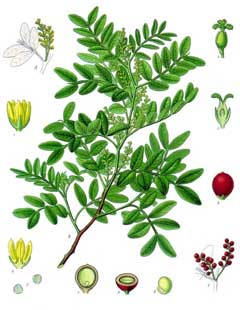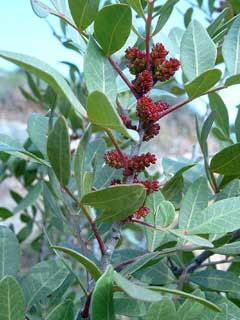 |
|
http://commons.wikimedia.org/wiki/File:Koeh-110.jpg |
 |
| http://commons.wikimedia.org/wiki/User:Lumbar |
Translate this page:
Summary
Bloom Color: Green. Main Bloom Time: Late spring, Mid spring. Form: Rounded, Spreading or horizontal.
Physical Characteristics

 Pistacia_lentiscus is an evergreen Shrub growing to 5 m (16ft) by 3 m (9ft) at a slow rate.
Pistacia_lentiscus is an evergreen Shrub growing to 5 m (16ft) by 3 m (9ft) at a slow rate.
See above for USDA hardiness. It is hardy to UK zone 9. It is in leaf all year, in flower from May to July, and the seeds ripen in October. The species is dioecious (individual flowers are either male or female, but only one sex is to be found on any one plant so both male and female plants must be grown if seed is required). . The plant is not self-fertile.
Suitable for: light (sandy), medium (loamy) and heavy (clay) soils and prefers well-drained soil. Suitable pH: neutral and basic (mildly alkaline) soils and can grow in very alkaline soils.
It cannot grow in the shade. It prefers dry or moist soil and can tolerate drought.
UK Hardiness Map
US Hardiness Map
Synonyms
Lentiscus massiliensis, Lentiscus vulgaris, Terebinthus lentiscus.
Plant Habitats
Edible Uses
A sweet liquorice-flavoured resin, called 'mastic', is obtained from incisions made into the bark of the trunk, but not into the wood[2, 11, 57, 64, 183]. The odour is agreeable and the taste mild and resinous, when chewed it becomes soft and so can easily be masticated[4]. It is chewed to strengthen the gums and as a breath sweetener and also used as a flavouring in puddings, sweets (including 'Turkish delight') cakes etc[2, 183]. It is also the basis of a Greek confectionery called 'masticha' and a liqueur called 'mastiche'[183, 238]. An edible oil is obtained from the seed[2, 89, 105].
References More on Edible Uses
Medicinal Uses
Plants For A Future can not take any responsibility for any adverse effects from the use of plants. Always seek advice from a professional before using a plant medicinally.
Mastic was at one time greatly used in herbal medicine, the resin obtained from the tree (see below for more details) being used[4]. It is little used in modern herbalism though it could be employed as an expectorant for bronchial troubles and coughs and as a treatment for diarrhoea[254]. The resin is analgesic, antitussive, carminative, diuretic, expectorant, odontalgic, sedative and stimulant[4, 46, 218]. It is mixed with other substances and used as a temporary filling for carious teeth[4, 7, 254]. Internally it is used in the treatment of diarrhoea in children[4, 7] and externally it is applied to boils, ulcers, ringworm and muscular stiffness[238, 254].
References More on Medicinal Uses
The Bookshop: Edible Plant Books
Our Latest books on Perennial Plants For Food Forests and Permaculture Gardens in paperback or digital formats.

Edible Tropical Plants
Food Forest Plants for Hotter Conditions: 250+ Plants For Tropical Food Forests & Permaculture Gardens.
More

Edible Temperate Plants
Plants for Your Food Forest: 500 Plants for Temperate Food Forests & Permaculture Gardens.
More

More Books
PFAF have eight books available in paperback and digital formats. Browse the shop for more information.
Shop Now
Other Uses
The resin 'mastic' is obtained by making incisions in the bark (not the trunk) of the tree from mid summer to the autumn[238]. It can be dried and used as a powder, or distilled for oil and essence[238]. It is used in high grade varnishes, as a fixative in perfumes, tooth pastes, glue (especially for false beards), embalming, a temporary filling for teeth etc[7, 11, 46, 57, 64, 171, 200, 238]. It is used to seal the edges of microscope mounts and is also chewed to preserve the teeth and gums[64]. An oil obtained from the seed is used for lighting, soap making etc[7, 89]. The leaves contain up to 19% tannin, they are often used as an adulterant of sumac, Rhus coriaria[223].
Special Uses
References More on Other Uses
Cultivation details
Landscape Uses:Border, Container, Erosion control, Screen, Specimen. Succeeds in any ordinary garden soil[1, 11], preferring a hot dry position in full sun[166]. Prefers a well-drained to dry sandy or stony alkaline soil[238]. This species is not very hardy in Britain. It normally requires the protection of a south-facing wall[11, 200] but can succeed in a hot dry position in the milder areas of the country[166]. The mastic tree is cultivated in southern Europe for its resin[46]. It is a very variable plant, a form with broad leaves yielding the best resin[64]. It is likely to need long hot and dry summers in order to yield its resin, and so is unlikely to produce it very freely in Britain. Any pruning that needs to be done is best carried out in the spring[238]. Dioecious, male and female plants must be grown if seed is required. Special Features:Not North American native, Inconspicuous flowers or blooms.
References Carbon Farming Information and Carbon Sequestration Information
Temperature Converter
Type a value in the Celsius field to convert the value to Fahrenheit:
Fahrenheit:
The PFAF Bookshop
Plants For A Future have a number of books available in paperback and digital form. Book titles include Edible Plants, Edible Perennials, Edible Trees,Edible Shrubs, Woodland Gardening, and Temperate Food Forest Plants. Our new book is Food Forest Plants For Hotter Conditions (Tropical and Sub-Tropical).
Shop Now
Plant Propagation
Pre-soak the seed for 16 hours in alkalized water[78], or for 3 - 4 days in warm water[1], and sow late winter in a cold frame or greenhouse[78, 113]. Two months cold stratification may speed up germination, so it might be better to sow the seed in early winter[113]. The germination is variable and can be slow. Prick out the seedlings into individual pots when they are large enough to handle and grow on the plants for at least their first winter in a greenhouse. Plant out into their permanent positions in early summer and consider giving some protection from winter cold for their first year or two outdoors[K]. Cuttings of half-ripe wood from juvenile trees, July in a frame[113]. Layering.
Other Names
If available other names are mentioned here
Native Range
TEMPERATE ASIA: Cyprus, Israel, Jordan, Lebanon, Syria (west), Turkey (west) EUROPE: Albania, Greece (incl. Crete), Croatia, Italy (incl. Sardinia, Sicily), Spain (incl. Baleares), France (s. & Corsica), Portugal AFRICA: Spain (Canarias), Algeria (north), Egypt (north), Libya (north), Morocco, Tunisia
Weed Potential
Right plant wrong place. We are currently updating this section.
Please note that a plant may be invasive in one area but may not in your area so it's worth checking.
Conservation Status
IUCN Red List of Threatened Plants Status :

Growth: S = slow M = medium F = fast. Soil: L = light (sandy) M = medium H = heavy (clay). pH: A = acid N = neutral B = basic (alkaline). Shade: F = full shade S = semi-shade N = no shade. Moisture: D = dry M = Moist We = wet Wa = water.
Now available:
Food Forest Plants for Mediterranean Conditions
350+ Perennial Plants For Mediterranean and Drier Food Forests and Permaculture Gardens.
[Paperback and eBook]
This is the third in Plants For A Future's series of plant guides for food forests tailored to
specific climate zones. Following volumes on temperate and tropical ecosystems, this book focuses
on species suited to Mediterranean conditions—regions with hot, dry summers and cool, wet winters,
often facing the added challenge of climate change.
Read More
Expert comment
Author
L.
Botanical References
1150200
Links / References
For a list of references used on this page please go here
Readers comment
| Add a comment |
|
If you have important information about this plant that may help other users please add a comment or link below. Only comments or links that are felt to be directly relevant to a plant will be included. If you think a comment/link or information contained on this page is inaccurate or misleading we would welcome your feedback at [email protected]. If you have questions about a plant please use the Forum on this website as we do not have the resources to answer questions ourselves.
* Please note: the comments by website users are not necessarily those held by PFAF and may give misleading or inaccurate information.
To leave a comment please Register or login here All comments need to be approved so will not appear immediately.
|
Subject : Pistacia_lentiscus
|
|
|
|